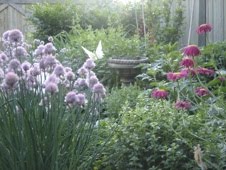 I let out a little gasp of excitement when I saw the bloodroot in bloom this morning. I thought it would be a few more days at least. Two years ago we were into May before the bloodroot really came into its own.
I let out a little gasp of excitement when I saw the bloodroot in bloom this morning. I thought it would be a few more days at least. Two years ago we were into May before the bloodroot really came into its own. The bloodroot seems to be multiplying successfully. There used to be three plants (and therefore three blooms) at the base of the serviceberry. This year, there are at least three blooms wherever there used to be one. At this rate, I should have a very impressive clump in about a decade. It will be worth the wait, no doubt. While the bloodroot flower is diminutive and short-lived the foliage continues to provide drama for a while to come. Once the flowers fade, giant, multi-lobed leaves similar to curvy fig leaves unfurl. Bloodroot is considered an ephemeral that goes dormant in the summer heat but in my garden the foliage lasts right through the summer. Sufficient shade and moisture seem to do the trick.
The bloodroot seems to be multiplying successfully. There used to be three plants (and therefore three blooms) at the base of the serviceberry. This year, there are at least three blooms wherever there used to be one. At this rate, I should have a very impressive clump in about a decade. It will be worth the wait, no doubt. While the bloodroot flower is diminutive and short-lived the foliage continues to provide drama for a while to come. Once the flowers fade, giant, multi-lobed leaves similar to curvy fig leaves unfurl. Bloodroot is considered an ephemeral that goes dormant in the summer heat but in my garden the foliage lasts right through the summer. Sufficient shade and moisture seem to do the trick. Tulipa Turkestanica made its debut today. Compared to
Tulipa Turkestanica made its debut today. Compared tolast year the blooms are a little behind schedule. Turkestanica is an outstanding performer: it is loaded with blooms and they last a long time.
 This is a species tulip. The squirrels do not appear interested in it. I planted Tulipa Saxatilis and "Little Beauty" with Turkestanica but they did not bloom last year. This year there is plenty of foliage to suggest they will.
This is a species tulip. The squirrels do not appear interested in it. I planted Tulipa Saxatilis and "Little Beauty" with Turkestanica but they did not bloom last year. This year there is plenty of foliage to suggest they will.























